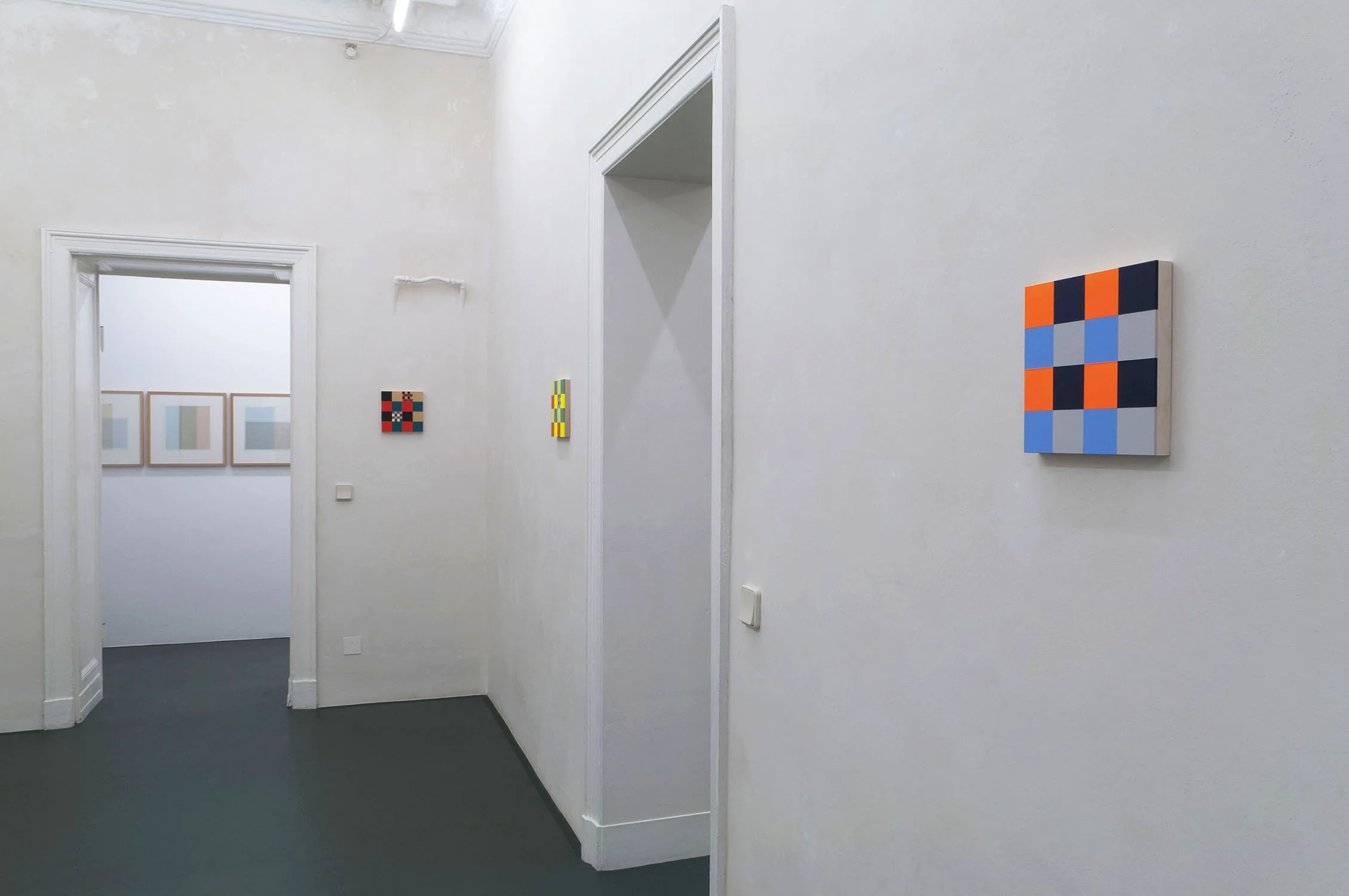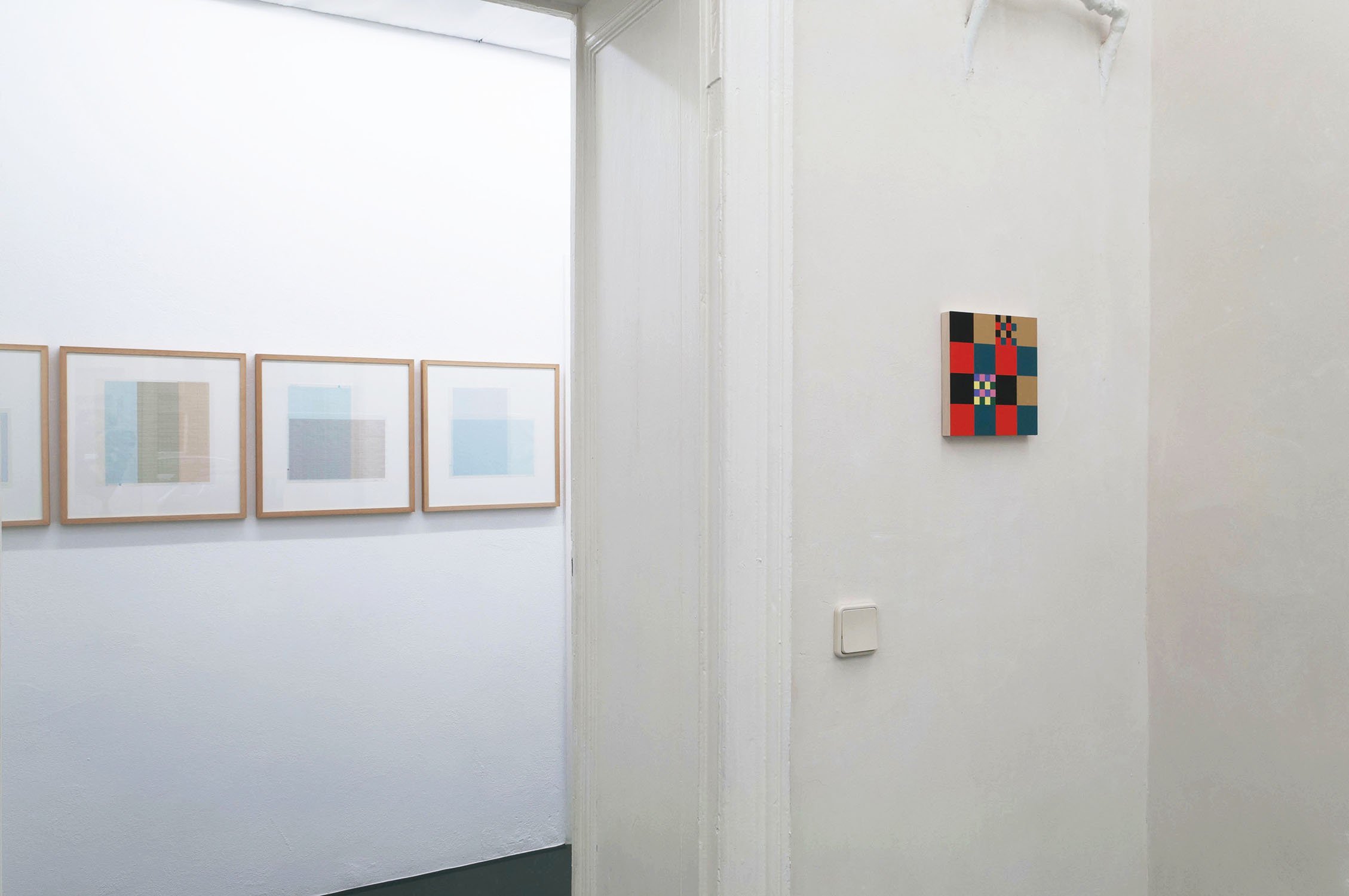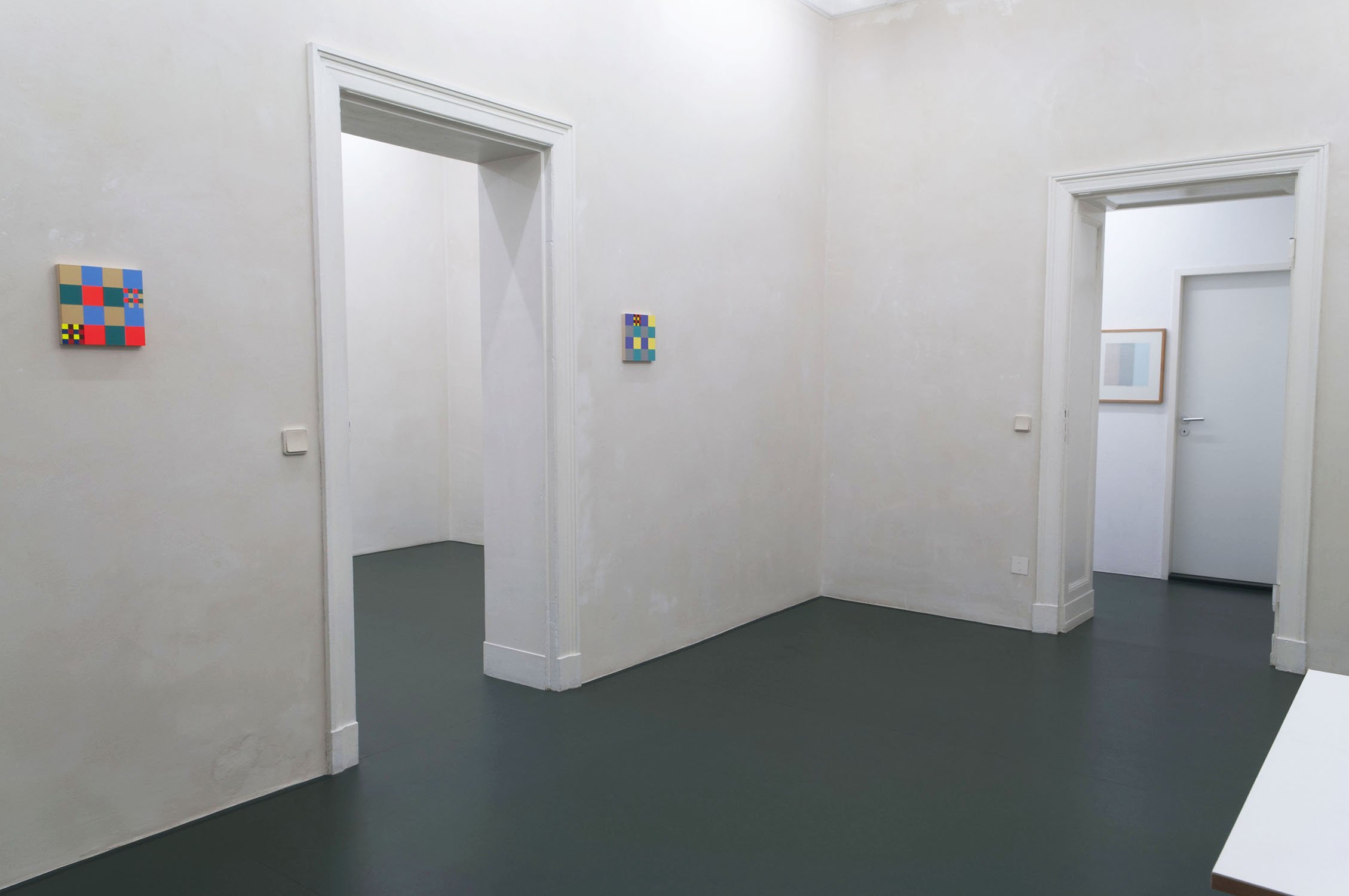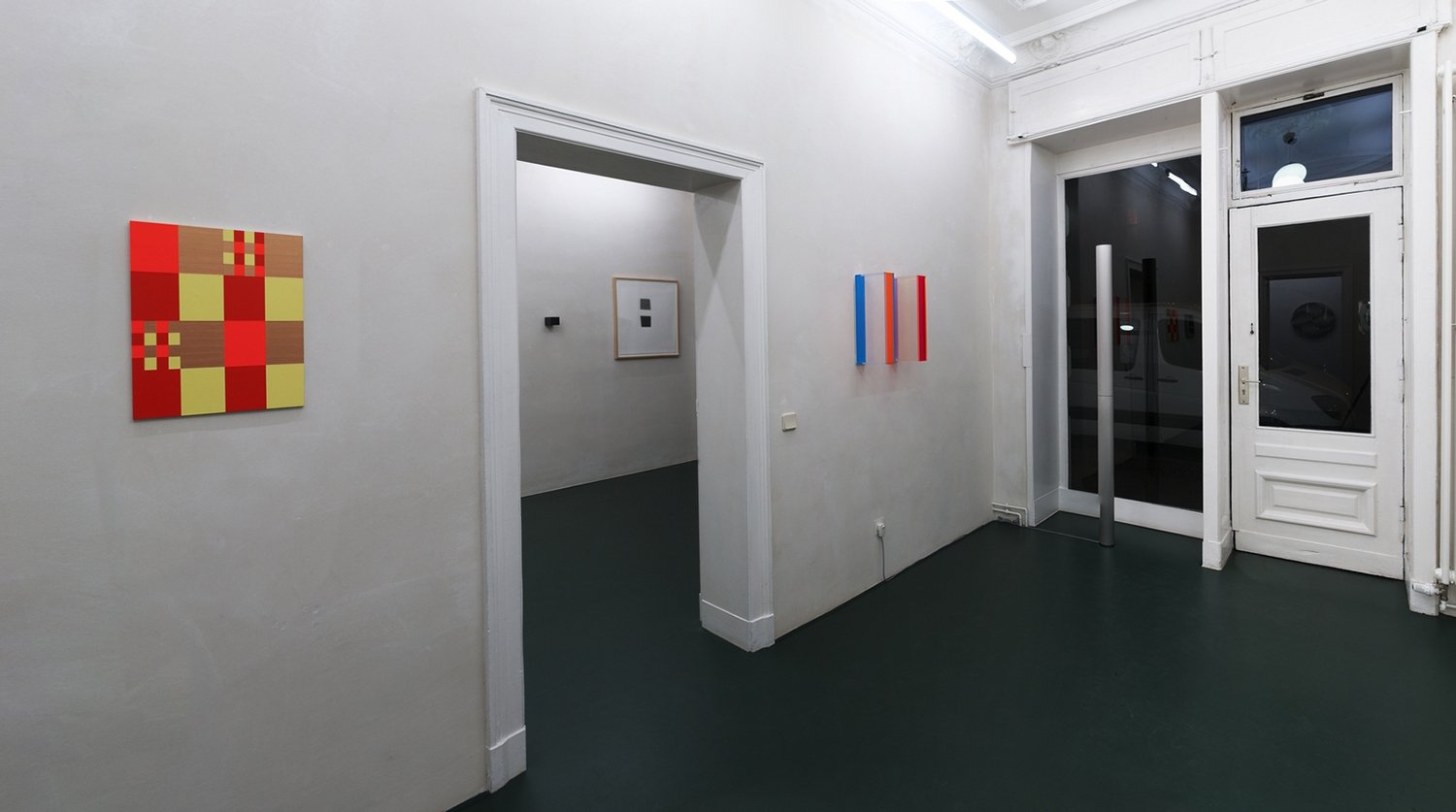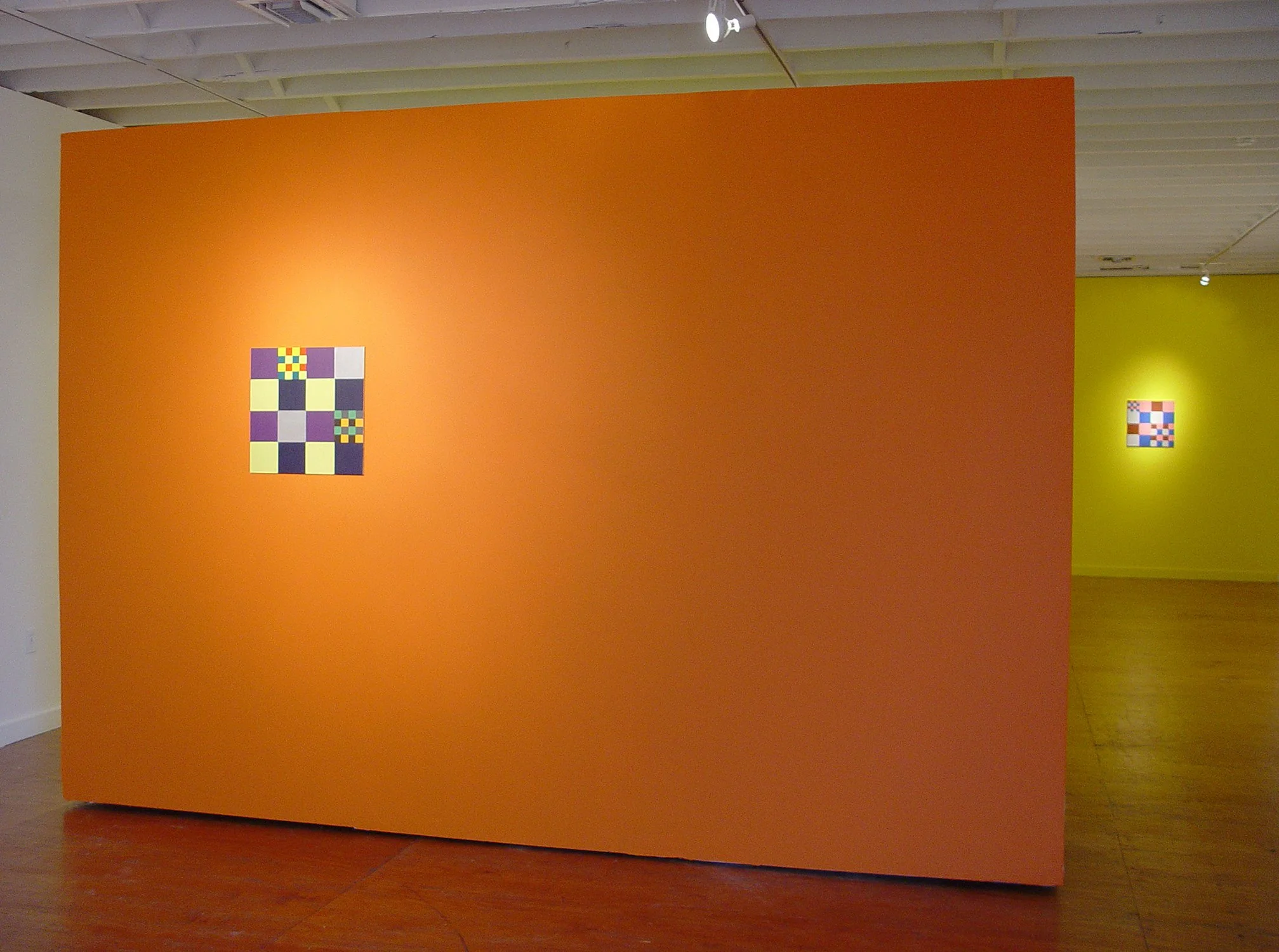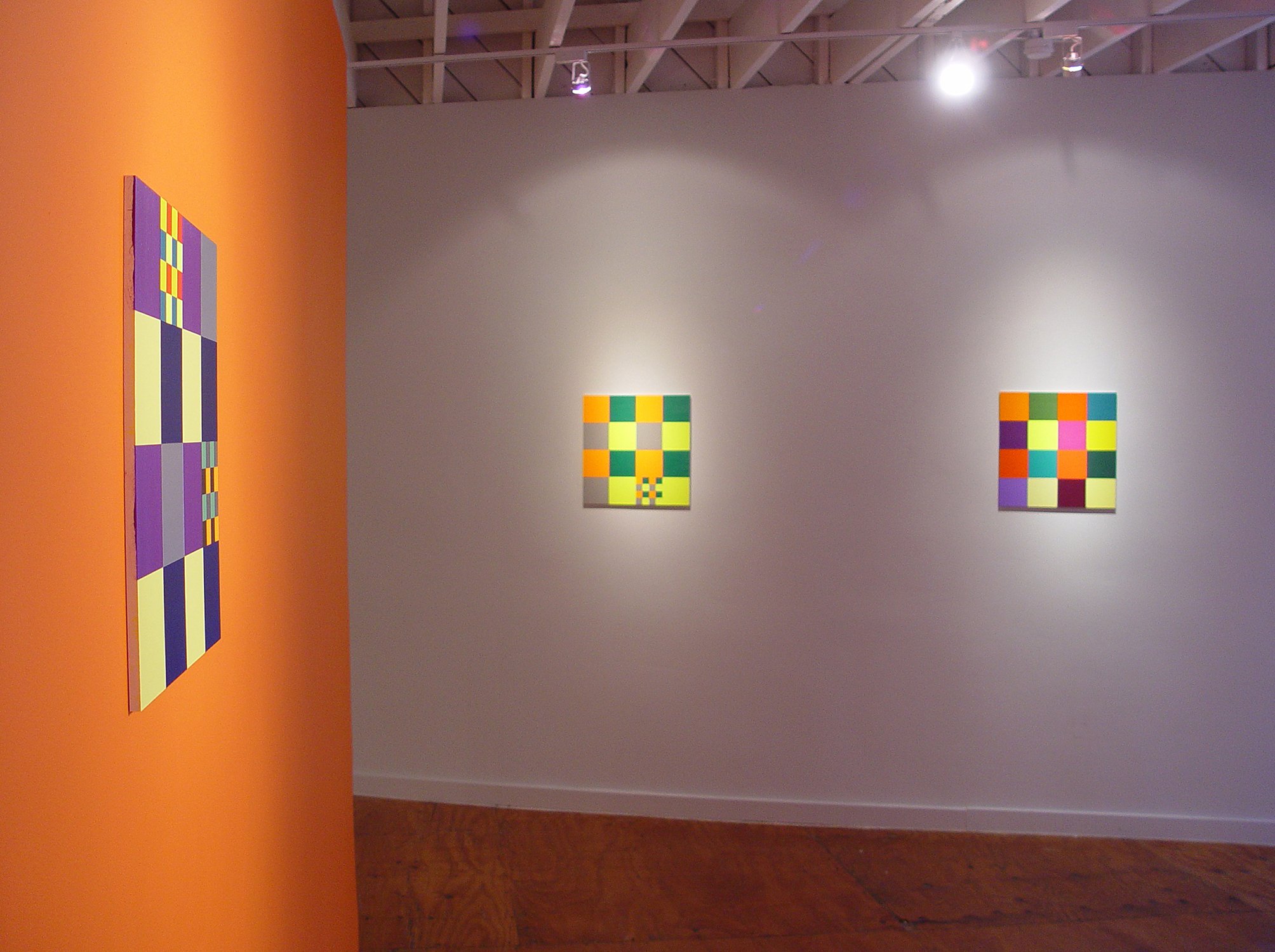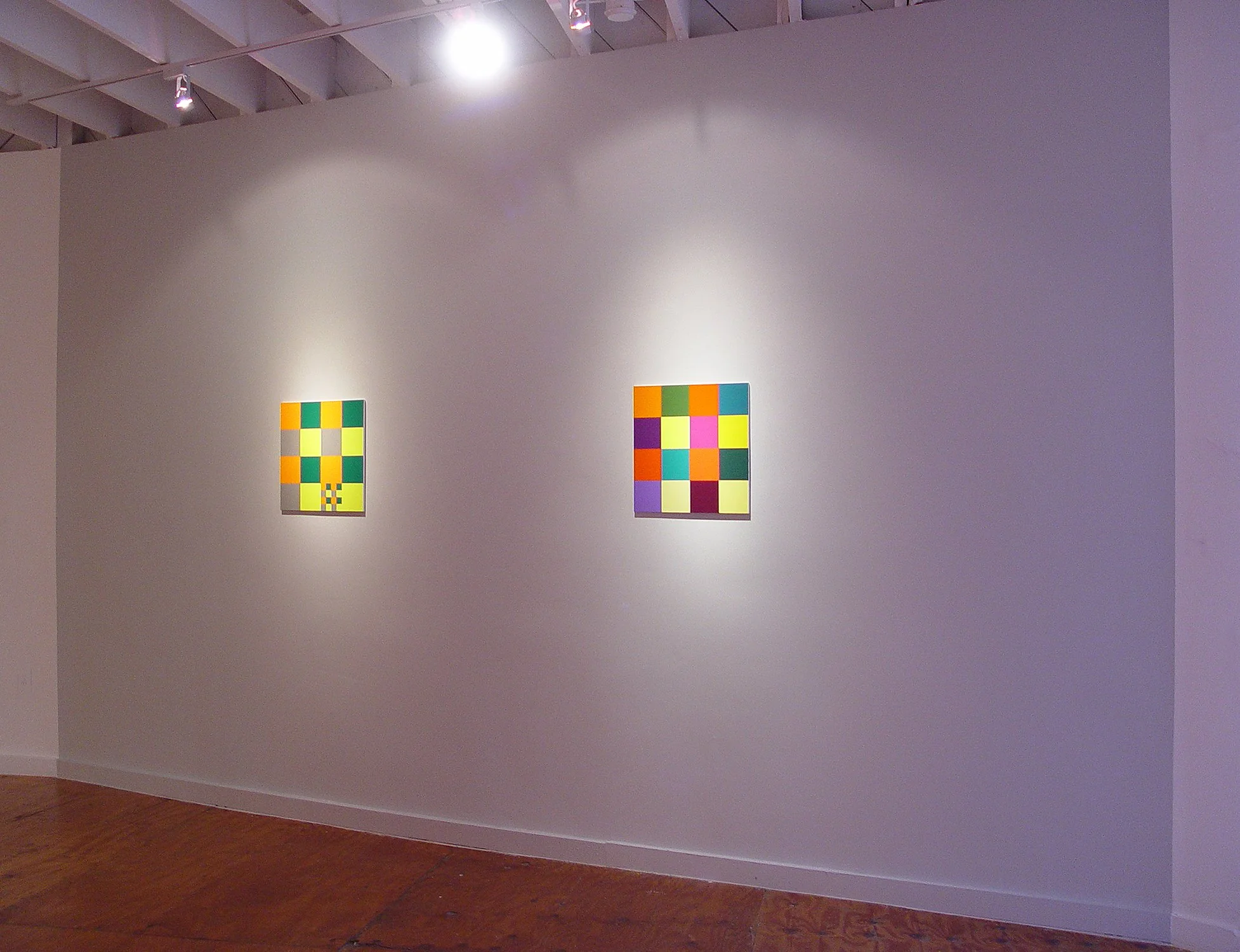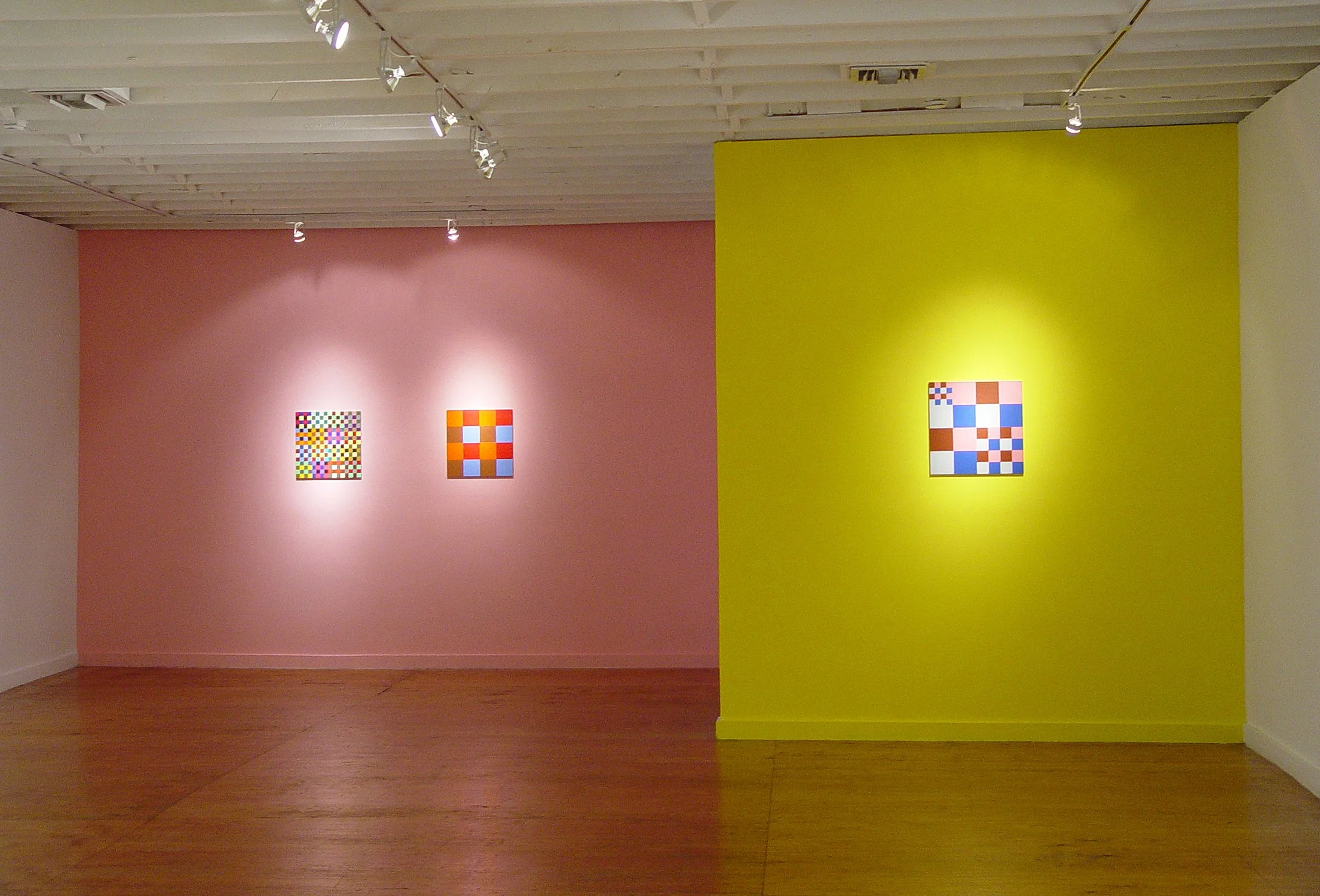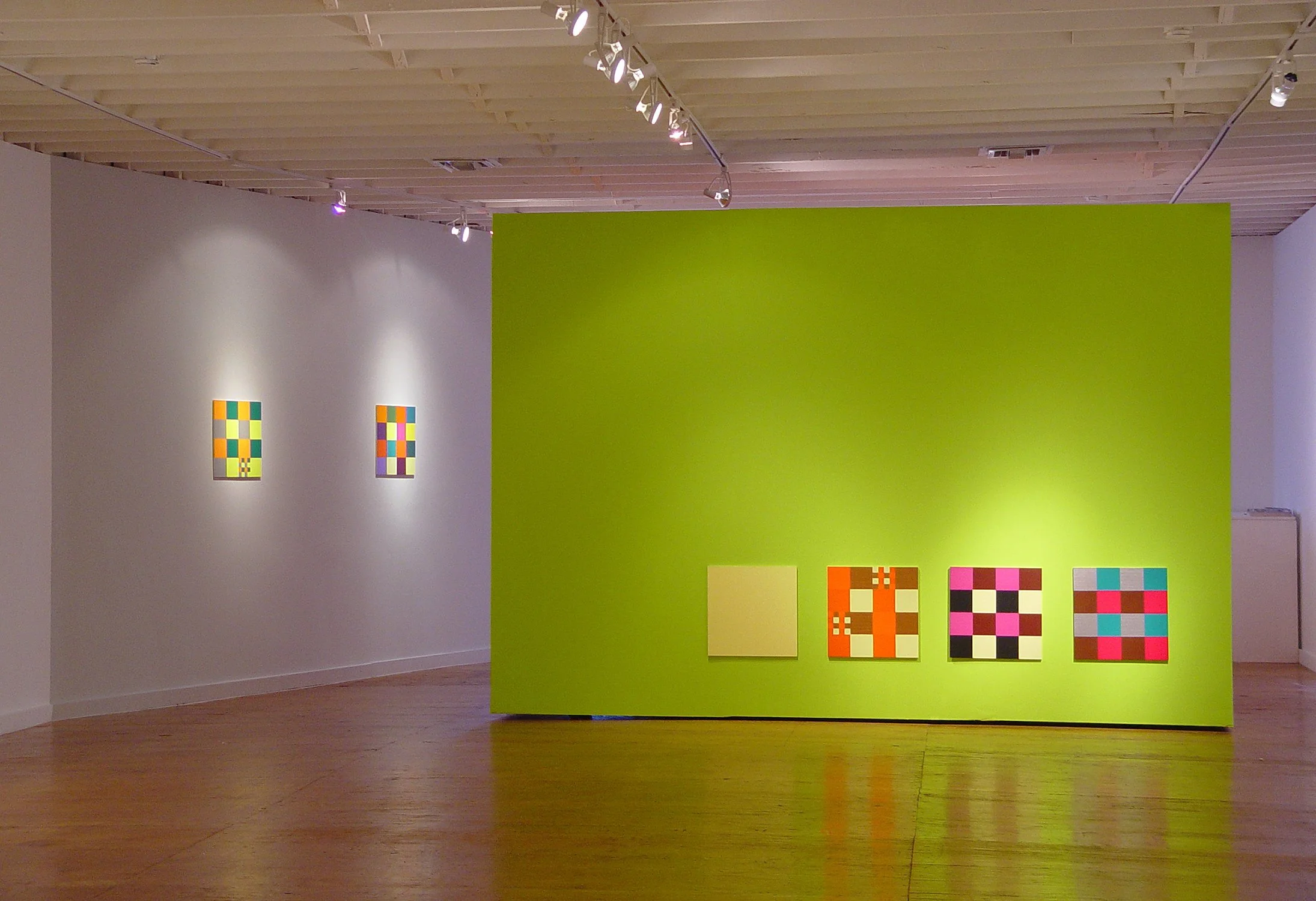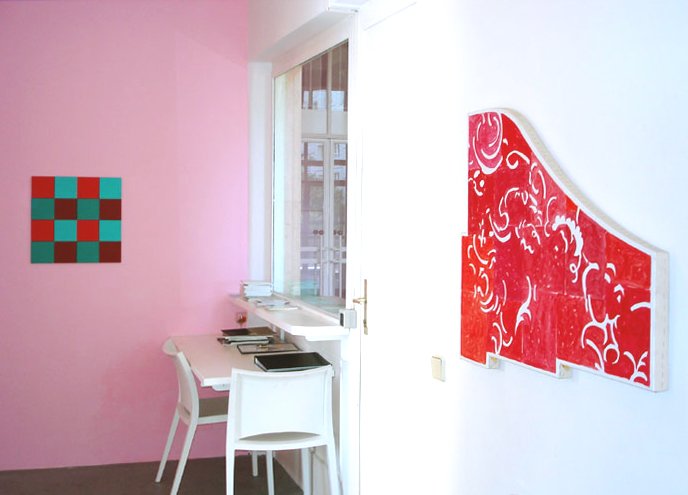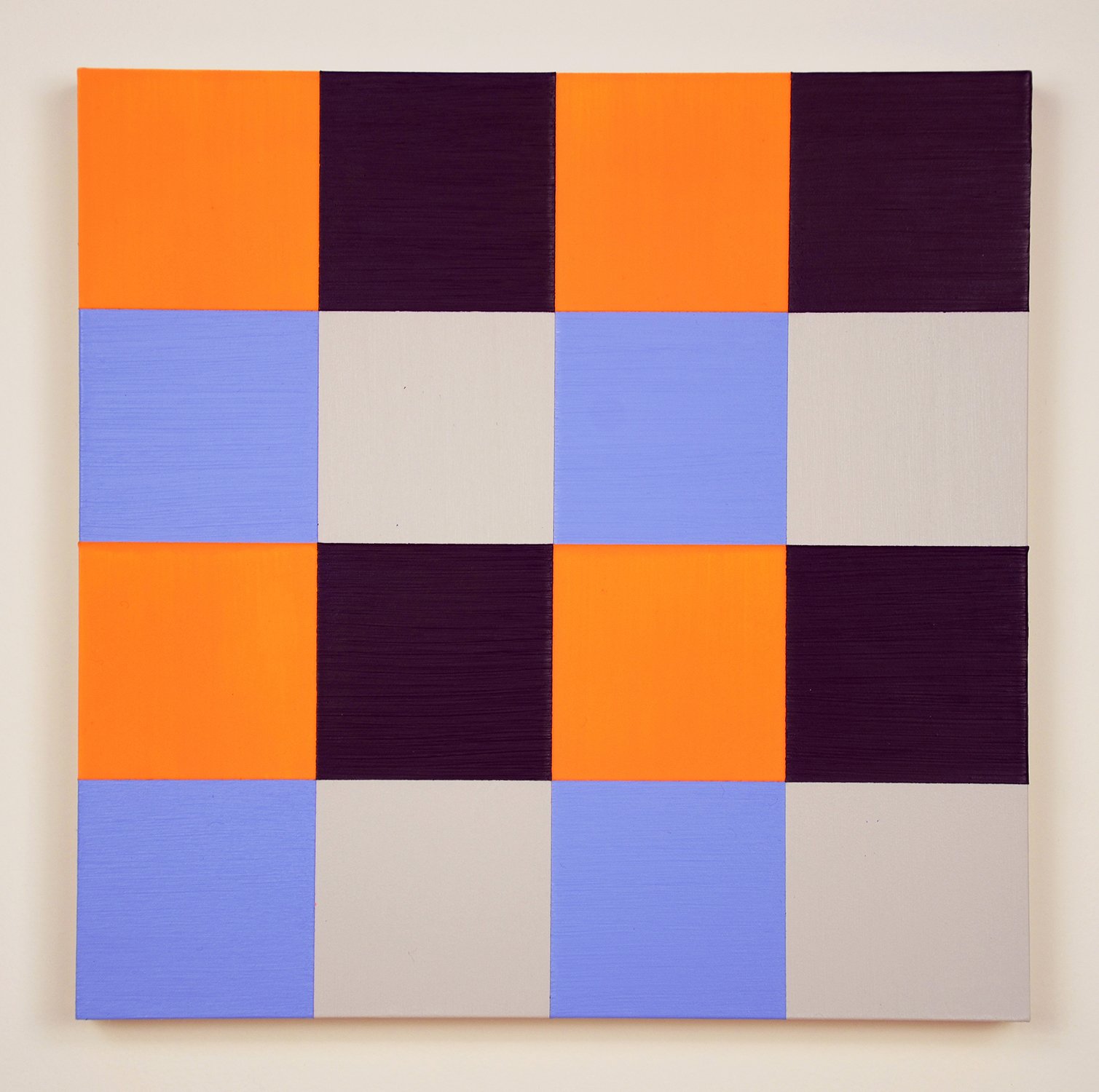Shuffle Paintings (2006 - present)
This ongoing series of painting was originally inspired by the shuffle feature on my old iPod back in 2006. I was (and still am) interested in the concept of random aesthetics. What happen when you deliberately remove conscious aesthetic decisions from an artwork?
Each painting in the first iteration of this series consisted of a square, checkered grid of four by four colors completely chosen at random. Each color was repeated four times and had the opportunity to touch each of the other three colors on several sides. The colors were selected from the complete library of acrylic paints produced by Golden Artist Colors, and included fluorescent, metallic, and iridescent colors painted on thin archival masonite panels, a homage to Josef Albers’s Homage to the Square series. The walls on which these paintings are installed are also sometimes painted colors chosen at random. To make matters more complex, later paintings in this series contained further, smaller Shuffle paintings placed within them, also created at random. The smaller Shuffles sometimes related to the color composition of the larger, surrounding paintings and sometimes not.
In 2010, for my first exhibition of this series at Alejandra von Hartz Gallery in Miami, Florida, I made a suite of Shuffle paintings directly inspired by the legendary salsa ensemble Fania All Stars. Each painting paid homage to a specific musician in the group, including Johnny Pacheco, Hector Lavoe, Celia Cruz, Ray Barretto, and Larry Harlow, among others. Depending on the specific make-up of the ensemble’s members at any given moment, the sound changed dramatically.
Several years later in 2014, I made another suite of petite Shuffle paintings for a two-person exhibition at Dr. Julius AP in Berlin, Germany, which were titled after the pseudonyms used by Modern and Contemporary artists I admire: Blinky Palermo, Judy Chicago, R. Mutt, James Kalm, etc. These paintings were also an attempt to see if an intense color experience could happen on a minute scale. I believe it can, of course. This strategy is the inverse of traditional color abstraction / field painting, which is generally very large and immersive in scale.
Exhibition Views
Exhibition view of Matthew Deleget & Hartmut Böhm: Related Lines, Dr. Julius / AP, Berlin, Germany, 2014
Exhibition view of Matthew Deleget & Hartmut Böhm: Related Lines, Dr. Julius / AP, Berlin, Germany, 2014
Exhibition view of Matthew Deleget & Hartmut Böhm: Related Lines, Dr. Julius / AP, Berlin, Germany, 2014
Exhibition view of Matthew Deleget & Hartmut Böhm: Related Lines, Dr. Julius / AP, Berlin, Germany, 2014
Exhibition view of group exhibition Private View. By Appointment., Dr. Julius / AP, Berlin, Germany, 2014
Exhibition view of Matthew Deleget: Ponte Duro/Get Hard, Temporary Contemporary, Bass Museum of Art, Miami Beach, FL; Curated by Bryan Granger, Knight Curatorial Fellow
Exhibition view of Matthew Deleget: Ponte Duro/Get Hard, Temporary Contemporary, Bass Museum of Art, Miami Beach, FL; Curated by Bryan Granger, Knight Curatorial Fellow
Exhibition view of Matthew Deleget: Ponte Duro/Get Hard, Temporary Contemporary, Bass Museum of Art, Miami Beach, FL; Curated by Bryan Granger, Knight Curatorial Fellow
Exhibition view of Matthew Deleget: Ponte Duro/Get Hard, Temporary Contemporary, Bass Museum of Art, Miami Beach, FL; Curated by Bryan Granger, Knight Curatorial Fellow
Exhibition view of Matthew Deleget: Ponte Duro/Get Hard, Temporary Contemporary, Bass Museum of Art, Miami Beach, FL; Curated by Bryan Granger, Knight Curatorial Fellow
Exhibition view of Matthew Deleget: Ponte Duro/Get Hard, Temporary Contemporary, Bass Museum of Art, Miami Beach, FL; Curated by Bryan Granger, Knight Curatorial Fellow
Exhibition view of Matthew Deleget: Color Climate, Alejandra von Hartz Gallery, Miami, FL, 2010
Exhibition view of Matthew Deleget: Color Climate, Alejandra von Hartz Gallery, Miami, FL, 2010
Exhibition view of Matthew Deleget: Color Climate, Alejandra von Hartz Gallery, Miami, FL, 2010
Exhibition view of Matthew Deleget: Color Climate, Alejandra von Hartz Gallery, Miami, FL, 2010
Exhibition view of Matthew Deleget: Color Climate, Alejandra von Hartz Gallery, Miami, FL, 2010
Exhibition view of Matthew Deleget: Color Climate, Alejandra von Hartz Gallery, Miami, FL, 2010
Abstraction to the Power of Infinity, Curated by Janet Kurnatowski, Ice Box Crane Arts, Philadelphia, PA, 2011 (left: Thornton Willis)
Exhibition view of Abstract Realities, University of Southern Queensland Gallery, Toowoomba, Australia, 2009
Exhibition view of Abstract Realities, University of Southern Queensland Gallery, Toowoomba, Australia, 2009
Exhibition view of Abstract Realities, University of Southern Queensland Gallery, Toowoomba, Australia, 2009
Exhibition view of 10 Years PS Amsterdam 1999-2009, Kunstruimte 09, Groningen, The Netherlands, 2009
Exhibition view of Transit - Abstract I, II, III, Project Space Henselmann Tower, Berlin, Germany, 2006
Exhibition view of Transit - Abstract I, II, III, Project Space Henselmann Tower, Berlin, Germany, 2006
Individual Paintings
Matthew Deleget, Shuffle (for Blinky Palermo), 2014, Acrylic on panel, colors chosen at random, 8 x 8 inches, #65
Matthew Deleget, Shuffle (for Claude Cahun), 2017, Acrylic on panel, colors chosen at random, 8 x 8 inches, #205
Matthew Deleget, Shuffle (for James Kalm), 2014, Acrylic on panel, colors chosen at random, 8 x 8 inches, #71
Matthew Deleget, Shuffle (for Judy Chicago), 2014, Acrylic on panel, colors chosen at random, 8 x 8 inches, #72, Private collection, Germany
Matthew Deleget, Shuffle (for Le Corbusier), 2014, Acrylic on panel, colors chosen at random, 8 x 8 inches, #68
Matthew Deleget, Shuffle (for Mark Rothko), 2014, Acrylic on panel, colors chosen at random, 8 x 8 inches, #67, Private collection, Germany
Matthew Deleget, Shuffle (for R. Mutt), 2014, Acrylic on panel, colors chosen at random, 8 x 8 inches, #69, Private collection, Germany
Matthew Deleget, Shuffle (for Rrose Selavy), 2017, Acrylic on panel, colors chosen at random, 8 x 8 inches, #204, Private collection, USA
Matthew Deleget, Shuffle (for Theo van Doesburg), 2014, Acrylic on panel, colors chosen at random, 8 x 8 inches, #70, Private collection, Germany
Matthew Deleget, Shuffle (for Weegee), 2014, Acrylic on panel, colors chosen at random, 8 x 8 inches, #66
Matthew Deleget, Shuffle (for Roberto Roena), 2010, Acrylic on MDF, colors chosen at random, 18 x 18 inches, #30
Matthew Deleget, Shuffle (for Jose Cheo Feliciano), 2010, Acrylic on MDF, colors chosen at random, 18 x 18 inches, #29
Matthew Deleget, Shuffle (for Ruben Blades), 2010, Acrylic on MDF, colors chosen at random, 18 x 18 inches, #26, Private collection, Milwaukee, WI
Matthew Deleget, Shuffle (for Celia Cruz), 2010, Acrylic on MDF, colors chosen at random, 18 x 18 inches, #28, Private collection, New York, NY
Matthew Deleget, Shuffle (for Hector Lavoe), 2010, Acrylic on MDF, colors chosen at random, 18 x 18 inches, #31, Private collection, New Jersey
Matthew Deleget, Shuffle (for Ismael Miranda), 2010, Acrylic on MDF, colors chosen at random, 18 x 18 inches, #25, Private collection, New York State
Matthew Deleget, Shuffle (for Santos Colon), 2010, Acrylic on MDF, colors chosen at random, 18 x 18 inches, #22, Private collection, New Jersey
Matthew Deleget, Shuffle (for Bobby Valentin), 2010, Acrylic on MDF, colors chosen at random, 18 x 18 inches, #23, Private collection, Charleston, SC
Matthew Deleget, Shuffle (for Felix Pupi Legarreta), 2010, Acrylic on MDF, colors chosen at random, 18 x 18 inches, #18, Private collection, New York, NY
Matthew Deleget, Shuffle (for Ray Barretto), 2010, Acrylic on MDF, colors chosen at random, 18 x 18 inches, #17, Private collection, New York, NY
Matthew Deleget, Shuffle (for Johnny Pacheco), 2010, Acrylic on MDF, colors chosen at random, 18 x 18 inches, #19, Private collection, Providence, RI
Matthew Deleget, Shuffle (for Larry Harlow), 2010, Acrylic on MDF, colors chosen at random, 18 x 18 inches, #20, Private collection, New York, NY
Matthew Deleget, Shuffle (for Nicky Marrero), 2010, Acrylic on MDF, colors chosen at random, 18 x 18 inches, #21
Matthew Deleget, Shuffle (for Yomo Toro), 2010, Acrylic on MDF, colors chosen at random, 18 x 18 inches, #24
Matthew Deleget, Shuffle (for the Fania All Stars), 2010, Acrylic on MDF, colors chosen at random, 18 x 18 inches, #32, Private collection, Miami, FL
